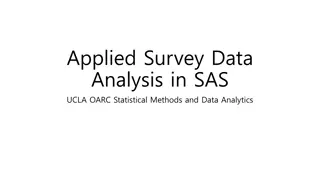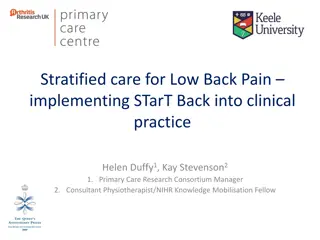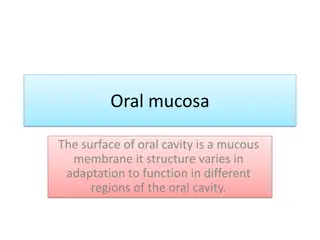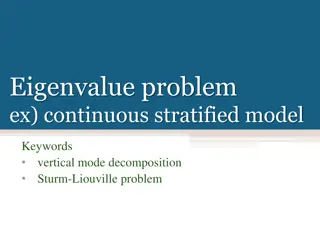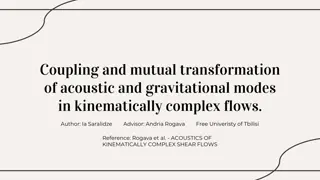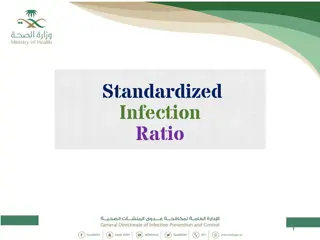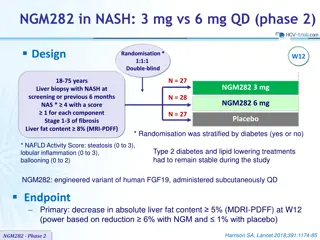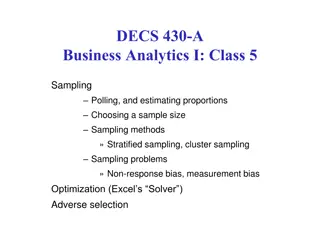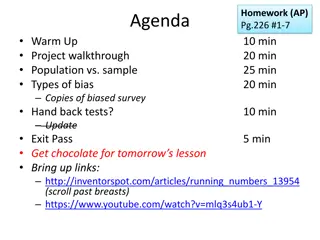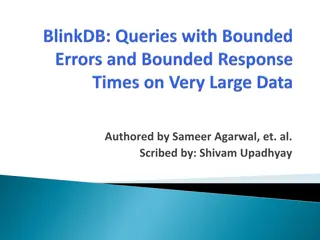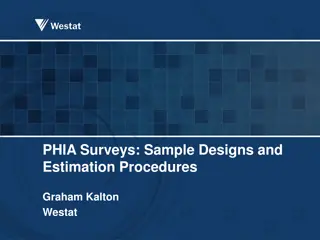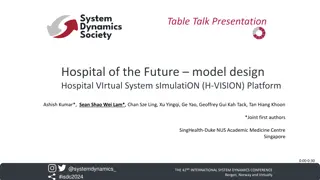Survey Data Analysis in SAS: Methods and Applications
Explore the nuances of survey data analysis in SAS, covering topics such as populations and samples, complex survey samples, stratified sampling, and more. Learn how to ensure representativeness in sampling and optimize precision of estimates in survey studies.
1 views • 31 slides
Tower Hamlets Annual Resident Survey 2023 Results Overview
The Tower Hamlets Annual Resident Survey 2023 provides insights into residents' feedback and opinions on various aspects. Conducted by MEL Research, the survey aims to capture a representative sample of residents in Tower Hamlets, highlighting statistical significance and methodology details. The su
1 views • 32 slides
Double-blind, Randomized Trial of Interatrial Shunt in HF Patients
This study details the principal results of the RELIEVE-HF trial, investigating the safety and effectiveness of the V-Wave Ventura interatrial shunt device in patients with heart failure with reduced and preserved ejection fraction. Key inclusion and exclusion criteria are outlined, emphasizing the
0 views • 30 slides
Social Organization: Bands, Tribes, and Chiefdoms Explained
In social organization, cultures have evolved through bands, tribes, and chiefdoms. Bands are small, egalitarian groups practicing hunting and gathering. Tribes support larger populations with agrarian lifestyles and temporary land ownership. Chiefdoms, the most complex, are stratified societies wit
1 views • 11 slides
Epithelial Tissue: Characteristics, Types, and Functions
Epithelial tissue is a crucial component of the body forming protective barriers, aiding in secretion, absorption, excretion, and more. Learn about its general characteristics, different types such as simple and stratified epithelium, glandular epithelium classification, and clinical applications li
0 views • 12 slides
Residual Inflammatory and Cholesterol Risks in Atherosclerosis Patients
In a secondary analysis of the CANTOS study, researchers evaluated the impact of residual inflammatory risk and residual cholesterol risk in a large cohort of atherosclerosis patients already receiving lipid-lowering therapy. Results showed the relative contributions of inflammation and cholesterol
1 views • 11 slides
Sampling Methods and Errors in Research
Sampling is crucial in research to draw conclusions about a population. Various methods like simple random sampling, stratified sampling, and systematic sampling help in selecting representative samples. Sampling error arises due to differences between sample and population values, while bias leads
1 views • 12 slides
Implementing STarT Back for Stratified Care in Low Back Pain Management
Helen Duffy and Kay Stevenson discuss the implementation of STarT Back, a screening tool designed to stratify low back pain patients for matched treatments based on modifiable risk factors. The tool is quick, validated, and helps clinicians identify high, medium, and low-risk patients for tailored p
0 views • 21 slides
Oral Mucosa: Structure and Classification
The oral mucosa is a mucous membrane that adapts to different functions in various regions of the mouth. It is classified into masticatory, lining, and specialized mucosa, each with distinct characteristics. The structure of oral mucosa resembles skin and consists of epithelium and connective tissue
4 views • 31 slides
Sampling Methods and Techniques
Learn about the differences between stratified random sampling and cluster sampling techniques, their advantages, and how to implement them effectively in surveys and data collection. Understand the importance of selecting a sample that accurately represents the population being studied, and discove
3 views • 14 slides
Gravity Waves as a Mechanism of Coupling Oceanic and Atmospheric Acoustic Waveguides to Seismic Sources
Direct excitation of acoustic normal modes in horizontally stratified oceanic waveguides is negligible for shallow earthquakes due to velocity disparities. This study evaluates the contribution of scattering by hydrodynamic waves in generating abyssal T-waves. The research explores the role of scatt
1 views • 6 slides
Society: Wealth and Assets Survey Research
The Wealth and Assets Survey (WAS) conducted by Oliver Tatum and Angie Osborn at the Understanding Society Research Conference in 2013 focuses on longitudinal issues, experiment design, research findings, and future plans related to the survey. The WAS background includes collecting data on personal
3 views • 28 slides
Cancer Care Transformation Alliance Overview
The Cancer Transformation Funding Alliance aims to enhance cancer care services by implementing Holistic Needs Assessments, Health & Wellbeing events, and Risk Stratified Pathways for different cancer sites. The program also focuses on developing Cancer Support Workers, improving data collection sys
1 views • 5 slides
Governing Equations and Model Reduction in Continuous Stratified Models
Detailed analysis of the governing equations in a continuous stratified model with vertical mode decomposition and Sturm-Liouville problem. The density perturbation and pressure perturbation are examined to derive a reduced 3D system. The Boussinesq approximation and hydrostatic balance are applied,
0 views • 36 slides
Coupling and Mutual Transformation of Acoustic and Gravitational Modes in Kinematically Complex Flows
This study explores the coupling and mutual transformation of acoustic and gravitational modes in kinematically complex flows. The research delves into phenomena such as stratified fluid, internal gravity waves, and formalism related to background flow and compressible cases. The presentation plan c
0 views • 20 slides
Standardized Infection Ratio (SIR) in Healthcare
The Standardized Infection Ratio (SIR) is a crucial metric used to monitor Healthcare-Associated Infections (HAIs) at various levels. It allows for improved risk adjustment and comparison by providing a single summary number. Standardization methods like direct and indirect standardization help in a
0 views • 44 slides
MFMSA_BIH Model Build Process Overview
This detailed process outlines the steps involved in preparing, building, and debugging a back-end programming model known as MFMSA_BIH. It covers activities such as data preparation, model building, equation estimation, assumption making, model compilation, and front-end adjustment. The iterative p
0 views • 10 slides
NGM282 in NASH Phase 2: 3 mg vs 6 mg QD Randomised Trial
This Phase 2 clinical trial compares the efficacy of NGM282 (3 mg vs 6 mg) versus placebo in patients with NASH. The primary endpoint is a 5% reduction in liver fat content at 12 weeks. Randomisation was stratified by diabetes status, and stable Type 2 diabetes and lipid-lowering treatments were mai
1 views • 6 slides
Female Ovary Histology and Function Overview
The female reproductive organ, the ovary, plays crucial roles in oocyte development, hormone production, and ovulation. Structurally, ovaries have a cortex and medulla, with follicles containing oocytes and surrounding cells. The primary follicle marks the onset of follicular maturation, leading to
0 views • 12 slides
Sampling Methods in Business Analytics
Sampling plays a crucial role in estimating proportions and making informed decisions in business analytics. From polling to estimating proportions, this class explores sampling techniques, sample size determination, and potential biases. Learn about choosing a sample size, stratified and cluster sa
3 views • 23 slides
Experimental Design and Bias in Statistics
Explore key concepts in statistics such as observational studies, experiments, bias, and sampling methods. Delve into the difference between observational studies and experiments, understand the impact of bias in research, and learn about sampling techniques like simple random sampling and stratifie
0 views • 22 slides
Histology of the Tongue: Structure and Function Overview
The tongue is covered by stratified squamous epithelium with various types of papillae on its dorsal surface, each serving specific functions such as taste perception and mechanical tasks. The filiform, fungiform, vallate, foliate, and circumvallate papillae are distinct in their appearance and dist
0 views • 10 slides
Analysis of 2019 Cal MediConnect Rapid Cycle Polling Project Findings
The findings from the Cal MediConnect Rapid Cycle Polling Project conducted in 2019 focused on comparing the experiences of Cal MediConnect (CMC) enrollees by county, race, language, and disability across different characteristics such as language and need for Long-Term Services and Supports (LTSS).
0 views • 104 slides
Influence of Income on Residential Yard Biodiversity in Baltimore
Residential yards in Baltimore, regardless of life stage, exhibit variations in biodiversity based on residents' income levels rather than other factors. The study explores how time and money influence plant diversity in yards, hypothesizing that residents with less money but more time will have hig
0 views • 25 slides
Observational Study on Red Light Cameras' Impact on Driver Behavior
The study focuses on determining if the installation of red light cameras at a busy intersection reduces the number of drivers running red lights. It discusses the data collection plan, including the focus on the number of cars running red lights, the sampling methods, such as simple random and stra
0 views • 17 slides
Overview of Salivary Glands Structure
Salivary glands play a crucial role in the production and secretion of saliva, aiding in digestion and oral health. The parotid gland is a compound tubuloacinar gland with serous characteristics, while the sublingual gland is a seromucous type. Minor salivary glands, found in carnivores, vary in com
0 views • 16 slides
BlinkDB: A Framework for Fast and Approximate Query Processing
BlinkDB is a framework built on Hive and Spark that creates and maintains offline samples for fast, approximate query processing. It provides error bars for queries executed on the same data and ensures correctness. The paper introduces innovations like sample creation techniques, error latency prof
0 views • 8 slides
PHIA Surveys: Overview of Sample Designs and Estimation Procedures
This presentation covers the nationally representative three-stage sample design of PHIA surveys, focusing on the sampling of Census Enumeration Areas (EAs), households, and persons. It discusses the importance of weighting to account for selection probabilities, nonresponse, and noncoverage, as wel
0 views • 15 slides
Improving Discharge Processes for Urology Patients
Addressing gaps in discharge processes for urology patients led to the implementation of a standardized pathway ensuring proper communication, transfer protocols, and follow-up strategies. The pathway includes informed patient transfers, detailed communication with primary care, holistic needs asses
1 views • 5 slides
Economic Foundations of Imperialism: Exploitation and Value Transfer
Imperialism primarily functions as an economic mechanism for exploiting value rather than seeking political dominance. The transfer of value occurs through mechanisms like unequal exchange, global value chain flows, and capital flows, leading to the long-term appropriation of value by imperialist na
0 views • 28 slides
Academic Discourse Instruction for Postgraduate Chinese Students at Edinburgh University
The study explores the response of postgraduate Chinese students to academic discourse instruction in an EAP pre-Masters course at Edinburgh University. Various aspects such as effective academic writing, meta-discourse in persuasive writing, and concession relations in argumentation are analyzed. R
0 views • 25 slides
First-Line Psychosocial Care for Children and Adolescents on Antipsychotics: Performance Measure Results
The performance measure assessed the use of first-line psychosocial care for children and adolescents on antipsychotics in Virginia, showing a total measure result of 68.98%. The measure aims to promote safer interventions before prescribing antipsychotic medications to minimize risks. Results were
0 views • 25 slides
Stratification
Concept of stratified sampling and its importance in ensuring representative samples in population studies. Learn how stratification helps control sample composition and reduce sampling errors. Discover the reasons for implementing stratification and its application in nationwide household surveys.
0 views • 26 slides
Sampling and Surveys: Understanding Population and Sample
In statistics, understanding the population and sample is crucial. Learn about different sampling methods, such as voluntary response and convenience sampling, and how they can introduce bias. Explore techniques like simple random sampling, stratified random sampling, and cluster sampling. Discover
0 views • 54 slides
OHT Indicators & Population Segmentation: Peterborough OHT Results January 2024
This report presents key indicators and segmentation results for the Peterborough OHT in January 2024. It includes rankings on overall OHT improvement indicators, results for target populations, and data stratified by sub-groupings. The report offers insights on areas for improvement and highlights
0 views • 86 slides
Social Structure of Tudor England
The social order of Tudor England under William Harrison's categorization encompassed gentlemen, citizens, yeomen, and artificers/laborers, each with distinct roles and status based on birth and occupation. The hierarchy ranged from the ruling monarch, through the peerage to commoners, reflecting a
0 views • 6 slides
Hospital of the Future Model Design: H-VISION Platform
Hospital of the Future model design project focuses on responding to ageing population challenges with innovative healthcare solutions. The team's approach includes long-range planning, stratified analysis, and simulation modeling to address key aspects such as patient forecasts, capacity estimation
0 views • 5 slides
Industrial Engineering Sampling Methods Overview
Learn about different sampling methods used in industrial engineering, including probability sampling (such as simple random sampling, stratified sampling, cluster sampling) and non-probability sampling (like volunteer and judgmental sampling). Understand the principles behind simple random sampling
0 views • 17 slides
Understanding Bias, Confounding Factors, Blocking, and Stratified Sampling in AP Statistics
Explore the concepts of bias, confounding factors, blocking, and stratified sampling in AP Statistics. Understand how bias can skew results, the impact of confounding factors on relationships, and methods to control for confounders. Learn how blocking ensures fair comparisons in experiments and how
0 views • 9 slides
Sampling Methods Explained: Random, Stratified, Quota
Learn about different sampling methods - Random Sampling, Stratified Random Sampling, and Stratified Quota Sampling - in this comprehensive guide. Understand how to select a representative sample from a target population and the advantages and disadvantages of each method for research validity.
0 views • 11 slides
